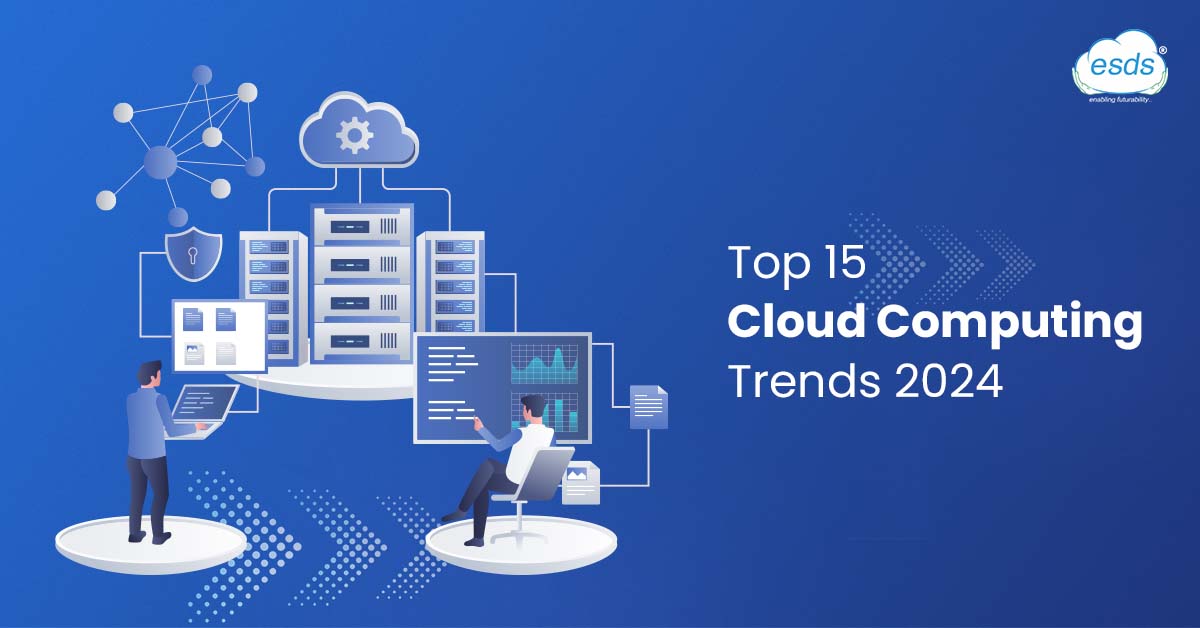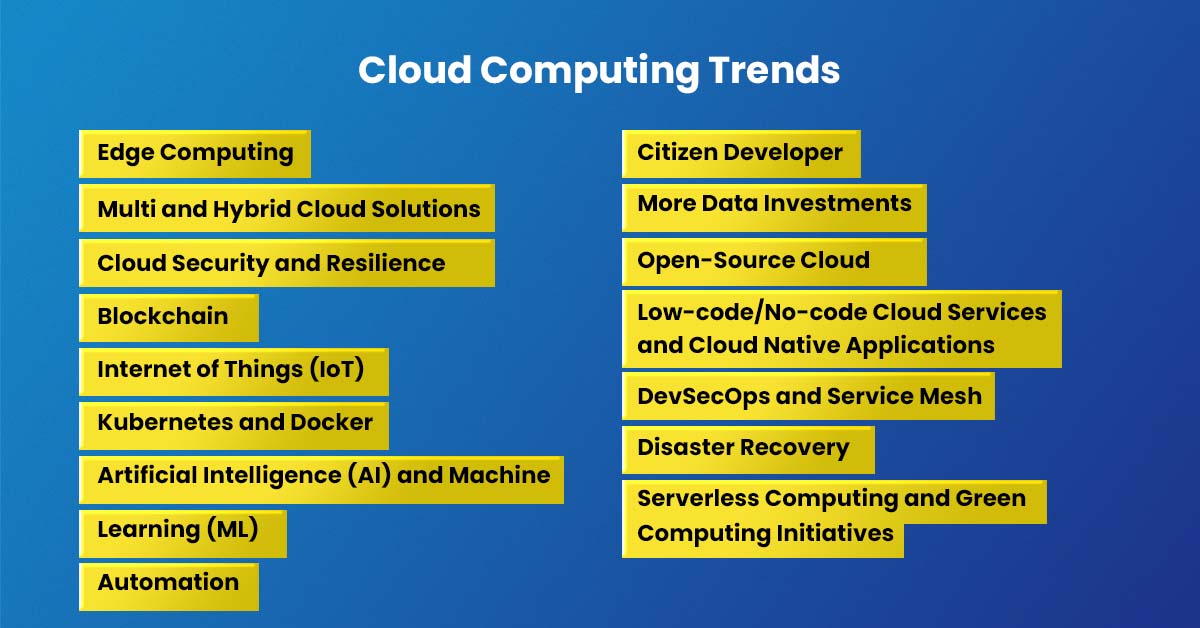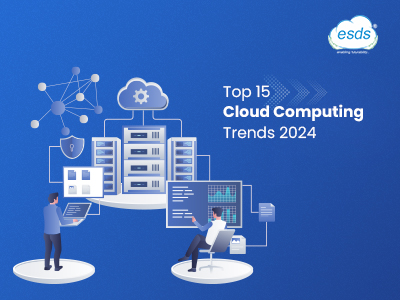Top 15 Cloud Computing Trends 2024

Market.us predicts the global cloud computing market will surpass $2,321.1 billion by 2032 with a compound annual growth rate (CAGR) of 16%. The reason for such enormous and rapid growth is that cloud computing has revolutionized the way businesses store, access, and share data and applications. By leveraging remote servers accessed via the internet, cloud computing allows for seamless collaboration, enhanced scalability, and reduced costs compared to traditional on-premises infrastructure. In today’s hyper-connected world, cloud computing has become a critical component of business technology strategies. It enables organizations to maintain business continuity, streamline operations, and access innovative technologies. Cloud computing also provides a flexible and scalable infrastructure that can adapt to the evolving needs of businesses.
Here are the Top 15 Cloud Computing Trends for 2024
1. Edge Computing: Empowering Real-time Data Processing
Definition and Benefits of Edge Computing
Edge computing is a paradigm that involves processing data at the edge of the network, closer to the source of data generation. By minimizing latency and bandwidth requirements, edge computing enables faster and more efficient data processing. It offers robust privacy, quick data transmission, and increased efficiency.
Integration of Edge Computing with Cloud Strategy
In 2024, edge computing will play a significant role in shaping cloud computing trends. Organizations will leverage edge computing to complement their cloud strategy, enabling real-time data processing and enhancing overall system performance. The integration of edge computing with the cloud will provide businesses with a competitive edge by enabling faster decision-making and improved user experiences.
2. Multi and Hybrid Cloud Solutions: Harnessing the Power of Cloud Diversity
Understanding Multi and Hybrid Cloud Solutions
Multi and hybrid cloud solutions involve the integration of multiple cloud environments, including public and private clouds, to meet specific business requirements. By spreading workloads across various cloud providers and on-premises frameworks, organizations can maintain control over their data and applications while leveraging the benefits of different cloud platforms.
Workload Optimization and Data Control
In 2024, businesses will continue to adopt multi and hybrid cloud solutions to optimize their workloads and ensure data control. These solutions offer flexibility, scalability, and cost-efficiency, allowing organizations to dynamically allocate resources based on their specific needs. By strategically distributing workloads, businesses can enhance performance, minimize downtime, and improve overall productivity.
3. Cloud Security and Resilience: Safeguarding Business Operations
The Growing Significance of Cloud Security
As businesses increasingly rely on cloud computing, security and resilience have become top priorities. Cloud providers are continuously investing in security measures to protect sensitive data and ensure business continuity. Key security features include data encryption, access controls, and disaster recovery capabilities.
Key Security Features: Data Encryption and Access Controls
In 2024, businesses will witness further advancements in cloud security. Data encryption will play a crucial role in protecting sensitive information, both in-transit and at-rest. Access controls will become more sophisticated, ensuring that only authorized individuals can access and modify data. Disaster recovery solutions will also continue to evolve, enabling organizations to quickly restore critical systems in the event of a cyber-attack or natural disaster.
4. The Role of Blockchain in Cloud Computing: Revolutionizing Data Management
Introduction to Blockchain Technology
Blockchain, a distributed ledger technology, is reshaping various industries and has significant implications for cloud computing. By integrating blockchain with cloud computing, businesses can create new applications and services that offer enhanced security, transparency, and decentralization. Blockchain’s ability to process vast amounts of data securely and economically holds great potential for industrial applications.
Blockchain-as-a-Service (BaaS) Solutions
Cloud providers now offer Blockchain-as-a-Service (BaaS) solutions, allowing businesses to develop and deploy blockchain applications in the cloud. These solutions eliminate the need for organizations to set up and maintain their own blockchain infrastructure, making blockchain technology more accessible and cost-effective. In 2024, the adoption of BaaS solutions will continue to grow, enabling businesses to leverage the benefits of blockchain technology without the complexities of implementation.

5. Internet of Things (IoT): Enabling Connected Systems
Expanding IoT Landscape
The Internet of Things (IoT) is experiencing rapid growth, with billions of devices connected to the internet and generating vast amounts of data. Cloud providers are investing in IoT technologies to support the increasing demand for connectivity and data management. IoT functions as a mediator, ensuring successful connections between devices, servers, and networks.
IoT and Data Management in the Cloud
In 2024, the integration of IoT with cloud computing will enable businesses to effectively manage and process the massive volumes of data generated by IoT devices. Cloud-based solutions provide the necessary infrastructure and scalability to handle IoT data, allowing organizations to derive valuable insights and make data-driven decisions. Furthermore, cloud providers will focus on enhancing security protocols to address IoT-related vulnerabilities and create a safer cloud environment.
6. Kubernetes and Docker: Streamlining Cloud Application Deployment
An Overview of Kubernetes and Docker
Kubernetes and Docker are open-source containerization platforms that simplify the deployment, scaling, and management of applications in the cloud. Kubernetes automates the orchestration of containerized applications, ensuring efficient resource allocation and workload management. Docker, on the other hand, enables developers to package applications into containers, providing portability and consistency across different environments.
Enhancing Efficiency with Containerization
In 2024, Kubernetes and Docker will continue to transform how businesses manage their cloud deployments. These technologies offer enhanced scalability, flexibility, and resource utilization, allowing organizations to efficiently deploy and scale applications based on demand. The adoption of containerization practices will enable businesses to streamline their development processes and accelerate time-to-market for new applications and services.
7. Artificial Intelligence (AI) and Machine Learning (ML): Driving Data-driven Insights
Leveraging AI and ML in Cloud Computing
Artificial Intelligence (AI) and Machine Learning (ML) technologies are closely intertwined with cloud computing. With the increasing availability of computational power and storage in the cloud, businesses can leverage AI and ML algorithms to gain valuable insights from large datasets. AI and ML enable automation, predictive analytics, and improved decision-making, enhancing the efficiency and competitiveness of organizations.
Automation and Self-Learning Competence
In 2024, AI and ML will continue to play a significant role in cloud computing trends. Increased automation will streamline business processes, reduce human error, and improve system reliability. Self-learning competence will enable AI and ML algorithms to continuously improve their performance and accuracy, resulting in more accurate predictions and recommendations. The integration of AI and ML capabilities into cloud-based applications and services will drive innovation and create new opportunities for businesses.
8. Automation in Cloud Computing: Enhancing Efficiency and Reliability
Automation is a vital element in cloud computing, enabling businesses to streamline their operations, improve efficiency, and reduce the risk of system slowdowns or downtime. In 2024, the adoption of automation technologies will continue to grow, driven by increasing investments, the emergence of citizen developer tools, and the integration of AI capabilities. Cloud vendors will release more user-friendly devices and platforms, making automation more accessible and convenient for businesses.
9. Citizen Developer Tools and AI Integration
The concept of citizen developers allows individuals without coding expertise to leverage connected systems and create customized automation solutions. Many tools with drag-and-drop interfaces enable users to connect APIs and develop automation workflows without writing code. Major companies like Microsoft offer platforms like Power Apps, Power Flow, Power AI, and Power Builder, empowering businesses to build complex applications that integrate with their existing tools. In 2024, the market will witness the release of more such tools, simplifying the development process and democratizing automation.
10. Data Analytics and GPU: Transforming Cloud-based Computing
Harnessing the Power of Big Data
Cloud computing enables businesses to analyze, gather, and store vast amounts of data in distributed computing environments. In 2024, organizations will focus on processing large data volumes by leveraging Graphics Processing Units (GPUs) for extensive parallel computing. GPUs offer significant computational power and can run multiple algorithms in parallel, enabling real-time analysis and insights.
The Rise of Graphics Processing Units (GPUs)
With the exponential growth of data, new computer architectures will emerge in 2024. To effectively process large datasets, businesses will distribute computational tasks across multiple machines, moving away from traditional Central Processing Unit (CPU) system architectures. GPUs, with their parallel processing capabilities, will play a crucial role in this transformation. Programmable GPUs can run a multitude of operations simultaneously, making them ideal for real-time analytics and complex computations. As a result, businesses can leverage the cloud to access flexible and agile computing resources, aligning their data processing capabilities with their business needs.
11. Open-Source Cloud: Customization and Control at Scale
Advantages of Open-Source Cloud Providers
Open-source cloud providers offer businesses greater customization options and control over their cloud infrastructure compared to traditional cloud providers. In 2024, more organizations will turn to open-source solutions to achieve resilience, scalability, and cost optimization. Open-source cloud platforms provide the flexibility to tailor cloud environments to specific business requirements, allowing for efficient resource allocation and improved system performance.
Resilience and Customization in the Cloud Framework
The adoption of open-source cloud solutions will continue to rise in 2024 as businesses seek greater control over their cloud frameworks. Open-source platforms offer extensive customization capabilities, enabling organizations to fine-tune their cloud infrastructure to align with their unique needs. The flexibility and resilience of open-source cloud providers make them an attractive choice for businesses looking to optimize their cloud operations and achieve long-term scalability.
12. Low-code/No-code Cloud Services and Cloud Native Applications: Simplifying Development
Accelerating App Development with Low-code/No-code Services
Low-code/no-code cloud services empower businesses to develop applications without extensive technical expertise. These services provide visual interfaces and pre-built components, enabling rapid application development and reducing the time and cost associated with traditional coding practices. In 2024, low-code/no-code platforms will gain popularity, allowing organizations to quickly build and deploy customized applications that interact seamlessly with their existing business tools.
Leveraging Cloud Infrastructure for Native Applications
Cloud-native applications are designed specifically for the cloud environment, leveraging its inherent scalability, availability, and resilience. In 2024, businesses will increasingly adopt cloud-native architectures to take advantage of cloud services and improve application performance. Cloud providers offer a range of services and tools that facilitate the development, deployment, and management of cloud-native applications. These tools enable businesses to build scalable and resilient applications that fully leverage the benefits of the cloud.
13. DevSecOps and Service Mesh: Integrating Security into Development
The Significance of DevSecOps Practices
DevSecOps is an approach that integrates security practices into the software development process. By adopting DevSecOps practices, businesses can ensure that security measures are implemented throughout the entire development lifecycle, reducing vulnerabilities and improving system resilience. In 2024, cloud providers will offer an array of services and tools to help organizations implement DevSecOps practices effectively.
Microservices Management with Service Mesh Solutions
Service mesh solutions provide centralized control and management of microservices-based architectures. These solutions offer features such as network load balancing, traffic management, and security, enabling businesses to efficiently manage their microservices. Cloud providers offer service mesh solutions that simplify the deployment and management of microservices, ensuring secure and reliable communication between services. In 2024, businesses will leverage service mesh technologies to enhance the scalability and resilience of their cloud-based applications.
14. Disaster Recovery in the Cloud: Ensuring Business Continuity
Cloud Computing as a Catalyst for Disaster Recovery
As businesses recognize the importance of business continuity, disaster recovery strategies are becoming increasingly crucial. Cloud computing enables organizations to restore critical systems and data in the event of a natural or manufactured catastrophe. Cloud providers offer disaster recovery solutions that ensure business continuity, minimizing downtime and data loss. In 2024, businesses will continue to rely on cloud-based disaster recovery solutions to safeguard their operations and mitigate the impact of potential disruptions.
Cloud-based Solutions for Business Continuity
Cloud-based disaster recovery solutions offer several advantages over traditional disaster recovery approaches. These solutions provide reliable and scalable infrastructure, ensuring rapid recovery and minimal downtime. In 2024, cloud providers will enhance their disaster recovery services, offering more robust and efficient solutions that align with businesses’ specific recovery objectives. The adoption of cloud-based disaster recovery strategies will enable organizations to maintain seamless operations and minimize the financial and reputational impact of potential disruptions.
15. Serverless Computing and Green Computing Initiatives: Efficiency and Sustainability
The Advantages of Serverless Computing
Serverless computing abstracts infrastructure management, allowing developers to focus solely on writing code. By eliminating the need to manage servers, businesses can reduce infrastructure costs and increase scalability. In 2024, serverless computing will gain further traction as organizations recognize its potential for cost optimization and operational efficiency. Cloud providers will continue to invest in serverless computing capabilities, expanding the range of services and tools available to businesses.
Cloud Providers’ Commitment to Green Computing
In response to growing environmental concerns, cloud providers are increasingly investing in green computing initiatives. These initiatives aim to reduce energy consumption, minimize carbon footprints, and promote sustainability. By leveraging renewable energy sources and implementing energy-efficient infrastructure, cloud providers can contribute to a greener and more sustainable future. In 2024, businesses will prioritize cloud providers that demonstrate a strong commitment to green computing, aligning their technology choices with their sustainability goals.
Conclusion:
Cloud computing is poised to shape the future of business technology in 2024 and beyond. The adoption of edge computing, multi and hybrid cloud solutions, and advanced security measures will enable organizations to leverage the full potential of cloud computing. The integration of emerging technologies like blockchain, IoT, Kubernetes, and AI/ML will drive innovation and create new opportunities for businesses. Automation, low-code/no-code services, and cloud-native development will simplify application development and accelerate time-to-market. Moreover, disaster recovery solutions, serverless computing, and green computing initiatives will ensure business continuity, efficiency, and sustainability. By embracing these cloud computing trends, businesses can stay ahead in an increasingly digital and competitive landscape.
- Top 5 Data Center Trends for 2024 - October 11, 2023
- Top 15 Cloud Computing Trends 2024 - October 4, 2023
- What is Infrastructure Monitoring and Why Infrastructure Monitoring Tool is Important for Your Business? - September 20, 2023
